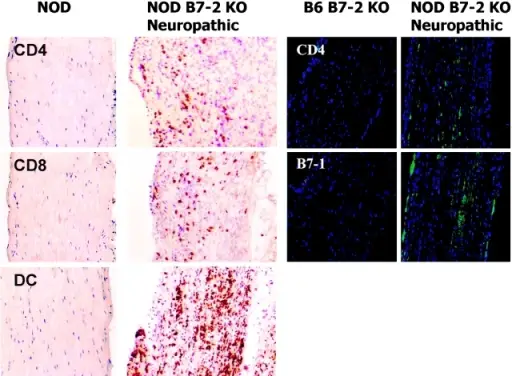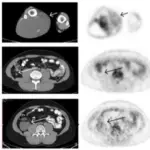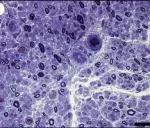
Patterns of Peripheral Neuropathies. Nerves of B7-2−/− neuropathic NOD mice are highly infiltrated with CD4+, CD8+ T cells, and dendritic cells. (Left panel) Frozen sections of the sciatic nerve of a 30-wk-old B7-2−/− neuropathic female and an age match control mouse were immunostained for the presence of CD4+ and CD8+ T cells and dendritic cells (DC). No infiltrate was detected in B7-2+/+ mice (dark oblong structures are nuclei of Schwann cells) whereas B7-2−/− mice presented abundant infiltration (dark round structures are stained cells). (Right panel) Frozen sections of the sciatic nerve of a 28-wk-old B7-2−/− neuropathic female and an age-matched B7-2−/− B6 male mouse were immunostained for the presence of CD4 (green, top panel) and B7-1 (green, bottom panel). No infiltrate or B7-1 staining was detected in a B7-2−/− B6 mouse whereas B7-2−/− NOD mice presented abundant infiltration and B7-1 expression. Development of spontaneous autoimmune peripheral polyneuropathy in B7-2-deficient NOD mice: Salomon B, Rhee L, Bour-Jordan H, Hsin H, Montag A, Soliven B, Arcella J, Girvin AM, Padilla J, Miller SD, Bluestone JA - The Journal of experimental medicine (2001). Not altered. CC.
Patterns of peripheral neuropathies are the anatomical pattern causing either sensory or motor damage or both.
Examples of patterns of peripheral neuropathies include:
- Mononeuropathies: Single nerve affected.
- Polyneuropathies: Multiple nerves affected.
- Mononeuritis multiplex: Several nerves damaged in a haphazard manner.
- Polyradiculoneuropathies: Diffuse symmetric symptoms due to nerve roots and peripheral nerves being affected.



